A chance to think through how the visual impact of text, image, and text with image.
24 Items in this Learning Collection
Collection Object
Collection Object
Collection Object
Collection Object
Collection Object
Collection Object
Collection Object
Collection Object
Collection Object
Collection Object
Collection Object
Collection Object
Collection Object
Collection Object
Collection Object
Collection Object
Collection Object
Collection Object
Collection Object
Collection Object
Collection Object
Copyright
All Rights Reserved
()
Beauty (Taifu)
Accession Number
1984/2.45
Title
Beauty (Taifu)
Artist(s)
Yokoi Kinkoku
Artist Nationality
Japanese (culture or style)
Object Creation Date
late 18th century - early 19th century
Medium & Support
hanging scroll, ink and color on paper
Dimensions
53 7/8 in. x 18 3/8 in. ( 136.8 cm x 46.7 cm )
Credit Line
Museum purchase made possible by the Margaret Watson Parker Art Collection Fund
Label copy
Gallery Rotation Fall 2013
Yokoi Kinkoku
Japan, 1761–1832
Beauty (Taifu)
Edo period (1615–1868)
Late 18th– early 19th century
Hanging scroll, ink and color on paper
Museum purchase made possible by the Margaret Watson Parker Art Collection Fund, 1984/2.45
Yokoi Kinkoku was born in Ôtsu, near the ancient capital of Kyoto, and trained as a Buddhist monk in the large monastery of the Zôjôji Temple in Edo (modern day Tokyo). Precocious and bright, Kinkoku quickly ascended the ranks, but at the age of eighteen he was expelled from the monastery because of his frequent visits to brothels. Moving to Kyoto, he continued to study Buddhism and eventually became a priest-in-residence at the city’s Gokurakuji Temple. Yet he never refrained from earthly pleasures, putting equal energy into gambling, singing, and playing music.
Painting was one of Kinkoku’s many talents, which included haiku poetry, sculpture, seal carving, and pottery. In this painting, he depicts a beautiful courtesan. The inscription, written by someone named Taiga, is a famous quote by the priest Ikkyu (1394–1481), who related in one of his numerous sermons how he encountered a beautiful courtesan who was so impressed by his teaching that she wanted to become a nun. Ikkyu told her, “Buddha sells teaching, a teacher sells Buddha; you sell your five-foot body in order to relieve all the worldly desires.” Indeed, this courtesan’s compassionate gaze resembles that of a bodhisattva, a figure believed by Buddhists to have chosen to remain on earth to guide others towards enlightenment.
Subject matter
A single courtesan with an inscription above her written by someone named Taiga, quoting the priest Ikkyu. One of Ikkyu's sermons told of how he had encountered a beautiful courtesan that was so impressed by his teachings that she wanted to become a nun.
Physical Description
A colored image of a single woman at the center of the scroll. She appears to be seated though there is nothing beneath her. Her kimono is grey with green grass designs and her under kimono is white. Her obi is a red and green stylized design. Above her head is an inscription.
Primary Object Classification
Painting
Primary Object Type
hanging scroll
Collection Area
Asian
Rights
If you are interested in using an image for a publication, please visit http://umma.umich.edu/request-image for more information and to fill out the online Image Rights and Reproductions Request Form.
Keywords
Figures
Japan
calligraphy
calligraphy (visual works)
courtesans
female
hanging scroll
hanging scrolls
human figures (visual works)
ink
kimono
kimonos
standing
1984/2.45
Title
Beauty (Taifu)
Artist(s)
Yokoi Kinkoku
Artist Nationality
Japanese (culture or style)
Object Creation Date
late 18th century - early 19th century
Medium & Support
hanging scroll, ink and color on paper
Dimensions
53 7/8 in. x 18 3/8 in. ( 136.8 cm x 46.7 cm )
Credit Line
Museum purchase made possible by the Margaret Watson Parker Art Collection Fund
Label copy
Gallery Rotation Fall 2013
Yokoi Kinkoku
Japan, 1761–1832
Beauty (Taifu)
Edo period (1615–1868)
Late 18th– early 19th century
Hanging scroll, ink and color on paper
Museum purchase made possible by the Margaret Watson Parker Art Collection Fund, 1984/2.45
Yokoi Kinkoku was born in Ôtsu, near the ancient capital of Kyoto, and trained as a Buddhist monk in the large monastery of the Zôjôji Temple in Edo (modern day Tokyo). Precocious and bright, Kinkoku quickly ascended the ranks, but at the age of eighteen he was expelled from the monastery because of his frequent visits to brothels. Moving to Kyoto, he continued to study Buddhism and eventually became a priest-in-residence at the city’s Gokurakuji Temple. Yet he never refrained from earthly pleasures, putting equal energy into gambling, singing, and playing music.
Painting was one of Kinkoku’s many talents, which included haiku poetry, sculpture, seal carving, and pottery. In this painting, he depicts a beautiful courtesan. The inscription, written by someone named Taiga, is a famous quote by the priest Ikkyu (1394–1481), who related in one of his numerous sermons how he encountered a beautiful courtesan who was so impressed by his teaching that she wanted to become a nun. Ikkyu told her, “Buddha sells teaching, a teacher sells Buddha; you sell your five-foot body in order to relieve all the worldly desires.” Indeed, this courtesan’s compassionate gaze resembles that of a bodhisattva, a figure believed by Buddhists to have chosen to remain on earth to guide others towards enlightenment.
Subject matter
A single courtesan with an inscription above her written by someone named Taiga, quoting the priest Ikkyu. One of Ikkyu's sermons told of how he had encountered a beautiful courtesan that was so impressed by his teachings that she wanted to become a nun.
Physical Description
A colored image of a single woman at the center of the scroll. She appears to be seated though there is nothing beneath her. Her kimono is grey with green grass designs and her under kimono is white. Her obi is a red and green stylized design. Above her head is an inscription.
Primary Object Classification
Painting
Primary Object Type
hanging scroll
Collection Area
Asian
Rights
If you are interested in using an image for a publication, please visit http://umma.umich.edu/request-image for more information and to fill out the online Image Rights and Reproductions Request Form.
Keywords
Figures
Japan
calligraphy
calligraphy (visual works)
courtesans
female
hanging scroll
hanging scrolls
human figures (visual works)
ink
kimono
kimonos
standing
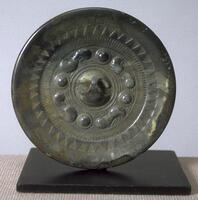
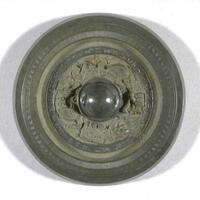






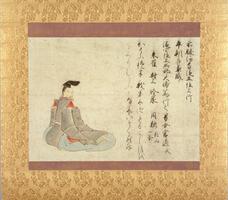
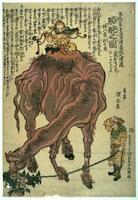

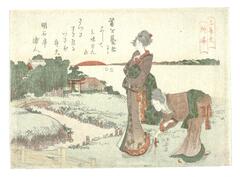
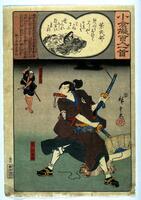



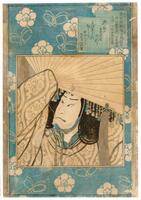
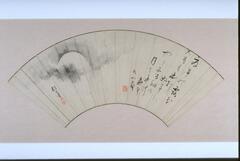

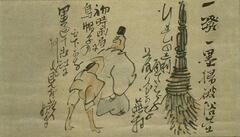

![In this monumental scroll, Nukina Kaioku has brushed a Chinese poem of his own composition, on the enduring theme of nature as refreshment for the spirit. Note his masterful variation of thick and thin strokes, wet and dry ink, stately and rapid movement.<br />The verses may be tentatively rendered into English as follows:<br /> Mandarin ducks enjoy the fresh water; their graceful forms glow as they pass through channels in the reeds.<br /> Pushing beyond the thickets [to the open pond], they call to one another again and again in the dawn.<br /> A crimson mist breaks through gaps in the glade, its glow warming hidden nests.<br /> Waking up with nothing to do, [I came here] to playfully row among the spring waves. In this monumental scroll, Nukina Kaioku has brushed a Chinese poem of his own composition, on the enduring theme of nature as refreshment for the spirit. Note his masterful variation of thick and thin strokes, wet and dry ink, stately and rapid movement.<br />The verses may be tentatively rendered into English as follows:<br /> Mandarin ducks enjoy the fresh water; their graceful forms glow as they pass through channels in the reeds.<br /> Pushing beyond the thickets [to the open pond], they call to one another again and again in the dawn.<br /> A crimson mist breaks through gaps in the glade, its glow warming hidden nests.<br /> Waking up with nothing to do, [I came here] to playfully row among the spring waves.](/media/W1siZiIsIjIwMjIvMDUvMjUvNDA4bXZmMmt5bF9kZWZhdWx0LmpwZyJdLFsicCIsInRodW1iIiwiMjQweDIwMCJdXQ?sha=1fda6bad9ec42b3f)


